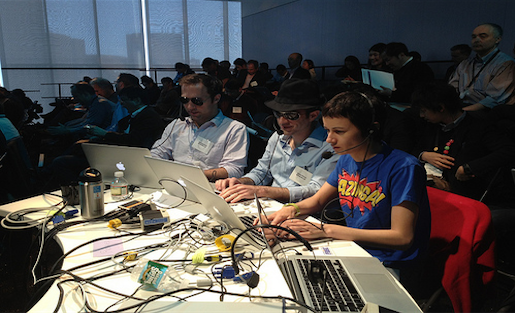Live-blogging is stressful. First, you need to find a reliable WiFi connection — and a way to sustain your device’s battery. Then, there’s the challenge of transcribing a speaker’s words in real-time. And if you want to go beyond transcription and create a polished piece of writing, complete with links to related resources, the challenge is even greater, especially when a speaker’s presentation isn’t well-organized.
Like so many things in life, live-blogging benefits from collaboration. At MIT’s Center for Civic Media, we’ve developed a system for collaborative live-blogging that works very well for us. We’ve live-blogged ROFLcon, where we turned Internet celebrities’ ad libs into thoughtful posts. We’ve live-blogged the Global Voices Summit in Nairobi, where we learned how to spell words like “Fulani” and “Rangi” on the fly. And we’ve live-blogged our own weekly events and annual conferences.
Here’s how we do it:
1. Choose a Live-Blogging Platform
We live-blog using Etherpad, a lightweight, open-source software application that allows collaborative document editing through a web browser. For people who don’t want to run their own Etherpad server, PiratePad offers a way to try Etherpad without installing a server — just click on the friendly frog and you’ll be given a PiratePad instance you can use.
It’s also possible to collectively live-blog using Google Docs or countless other web-based text editors. Google Docs is particularly helpful when you have many people watching the blogging take place, as Etherpad reaches a viewer limit.
If you’d like to publish content in small chunks, rather than complete posts, you may wish to use the Live Blogging WordPress plugin, which updates pages dynamically — allowing readers to view new content without reloading the page.
CoverItLive is a flashy paid service with lots of features, but much heavier page loads than a standard blog post. It’s useful for large conferences where you expect heavy chatroom participation and if you’d like to aggregate numerous other backchannels.
2. Clarify and Assign Roles
Once we start an Etherpad for an event, we share the link with other live-bloggers in the room to see if they want to help. Etherpad’s included chat window allows us to discuss what role each blogger will assume; otherwise, whoever is first begins the process by becoming the “transcriber” (described below). Taking the time to define roles upfront saves time and prevents the frustrating experience of writing over each other’s work.
We’ve found that three people, or six hands, make the ideal live-blogging team. Each person assumes one of the following roles:
The Transcriber takes on the bulk of the task of capturing what the speakers are saying in real-time, as faithfully as possible. This doesn’t necessarily mean recording a speaker’s words verbatim — sometimes a transcriber’s job can include paraphrasing a particularly convoluted sentence or adding emphasis and clarifications implied by tone of voice. Often the transcriber will attempt to capture literal quotes, designating them as such in the text. (At the Center, we videotape many of our events, and we’ve found that denoting the timestamp of key quotes helps the video editors put together a compelling summary video.)
The Linkhound searches for relevant links to the projects the speaker mentions, as well as the original sources of studies and quotations, all without interrupting the speaker. This person is also free to add nice-to-have information like Twitter handles and cellphone photos of the event. Some presentations require more of a Linkhound than others, so the Linkhound may end up having time to also publish occasional quotes to Twitter, which helps more people access highlights from the event in real time.
Finally, the Polisher & Narrative Threader pays attention to the overall theme of the talk, even when a speaker doesn’t clearly establish a theme, and transforms the transcription into a cohesive, well-framed argument fit for a blog post — something that someone not at the event might actually be interested in reading. The polisher often works 10-20 minutes behind the transcriber.
other live-blogging roles
With more hands, other roles are possible:
The Live-tweeter: While some people are willing to follow an event via an Etherpad, and others will wait to read a blog post, some like to discover the discussion via Twitter. A fourth participant could take responsibility for capturing pithy quotes and short talk summaries and posting them to Twitter. A live-tweeter sometimes helps the transcriber by catching quotes she might have missed.
The Factchecker: If you’re blogging a political speech, or a presentation whose speaker is making dubious claims, one member of the live-blogging team could focus on fact-checking in real time. Note that this will change the document you’re writing from a straight account of the event to one that attempts to untangle and verify the speaker’s statements.
Many hands make for light work if you assume roles to avoid stepping on each other’s toes.
I’m curious to hear:
- What are your favorite live-blogging tools?
- Are there important roles I’ve missed?
- Who have you seen do a really nice job of live-blogging? (I think Gizmodo’s meta-coverage of Apple and other major product launches is the most advanced live-blogging team I’ve seen.)
This post was written with Ethan Zuckerman, director of MIT’s Center for Civic Media and co-founder of the citizen media community of Global Voices. Zuckerman is the co-author, with Bruno Giussani, of the free ebook, “Tips for Livebloggers.”
Matt Stempeck is a researcher at the MIT Media Lab and the Center for Civic Media. He studies topics like the future of journalism, designs products like LazyTruth, and blogs. Mavis Beacon worked for him.

